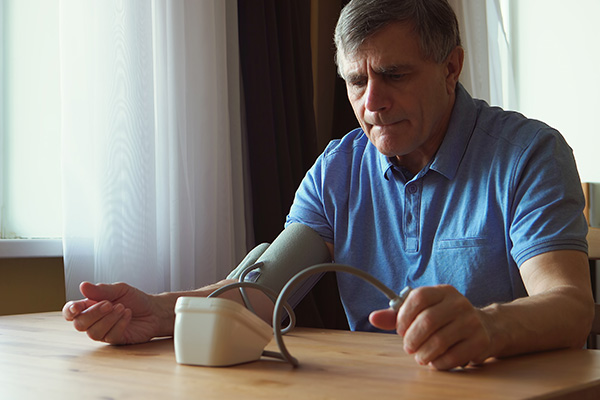![]()
Blog @ SunTech
Advice from the BP Measurement Experts
Home Blood Pressure Devices Wrong 70% Of The Time

A recent study published in the American Journal of Hypertension shows the majority of blood pressure devices sold and used in people’s homes are potentially inaccurate as much as 70% of the time. Since lots of people measure their blood pressure at home to track their cardiovascular health, this study is understandably noteworthy. But what else can we learn from it?
You Get What You Pay For
First, let’s talk a little bit about oscillometry. Oscillometry is the general method that most automatic blood pressure devices use to measure blood pressure. This is true for devices in the home, in doctor’s offices, and even in hospitals. As the study pointed out, while the oscillometric method is commonplace, there are differences between devices from different manufacturers because of the mathematical formulas and algorithms used to calculate systolic and diastolic blood pressure values. The math is proprietary, and most private companies that have their own oscillometric technology—including SunTech—guard those calculations very closely.
Why? Well, the simple answer is that the math behind better-performing technologies is based on actual clinical research conducted over long periods of time—in SunTech’s case, decades. This research, and the analysis of the resulting data, is a significant and expensive undertaking that can provide an important commercial advantage when it comes to a device’s clinical accuracy. So if companies had to share their data with the rest of the world, what would be the incentive to conduct all of that research in the first place? So, proprietary data can result in devices with better clinical performance, which is better for physicians and patients. I say ‘can’ because it’s no guarantee, as this study clearly illustrates.
If the Cuff Fits...
One other fact about this study merits some additional digital copy. The authors discuss several potential reasons for the reported inaccuracy of almost 70% of the home blood pressure devices analyzed. But there is one that the authors mention briefly that could actually explain a lot. And that’s the blood pressure cuff itself. Now, it’s pretty common for folks to call the entire device—digital box, hose, and fabric that wraps around the arm and inflates--a ‘BP cuff’. But what I’m talking about is just the part that goes on the arm. That’s the actual blood pressure cuff.
Blood pressure cuff sizes are incredibly important for any oscillometric blood pressure device. The math behind these devices assumes that the correctly sized cuff will be used on the patient. See, because of the physics around how non-invasive blood pressure is measured, there’s no such thing as a ‘one size fits all’ blood pressure cuff. To be accurate, the cuff must be sized correctly according the circumference of the patient’s upper arm, for a variety of reasons. The researchers in this study reported that the mean arm circumference of study participants was a bit less than 33cm, and that increasing arm circumference was a statistically significant predictor of an inaccurate measurement.
Now, 33cm is on the high side for most standard, adult-sized blood pressure cuffs. Since home blood pressure devices typically include only a single cuff, manufacturers generally pick a very middle-of-the-road size for the cuff, hoping that it will cover the majority of arm sizes. But in the case of this study, the mean arm circumference is already pushing the upper limit of a middle-of-the-road adult cuff. So it should come as no surprise that as arm circumference increases, accuracy suffers. The researchers didn’t publish any data on the sizes of the BP cuffs that were used with the home BP devices, and I think that would have been helpful.
But the point here is that that size matters when it comes to BP cuffs and oscillometric devices. It matters a lot. It might even matter more than the math inside the device—although that matters too. So if you find yourself in need of a home blood pressure device, the first thing that you need to do is make sure that the cuff that comes with it is the right fit for your arm. Your doctor can help you figure this out if you bring it with you to the doctor’s office. If the cuff isn’t the right size, contact the manufacturer and see if they have a cuff that is.
In fact, even when you are having your blood pressure measured in a doctor’s office, it’s not a bad idea to ask the clinician taking your BP to double-check the sizing of the cuff to your arm, as other studies have shown that using the incorrectly sized cuff in clinical settings is commonplace as well.
Maybe We’re Barking Up The Wrong Tree?
While data that points to inaccuracies with home blood pressure devices is important, for professionals in the medical world, it’s not exactly news. And while asking how to make home BP devices better is fine, we should also be asking if there are more accurate alternatives to home BP. And the answer is yes. 24-hour Ambulatory Blood Pressure Monitoring (ABPM) is widely considered to be the gold standard for assessing a patient’s blood pressure.
Unfortunately, the reimbursement for ABPM in the United States is currently quite low, and only valid for diagnosing white coat hypertension. In other countries, like the U.K., ABPM is becoming recognized as an important tool for treating general hypertension, and is therefore being treated as such by government and private payers.
At SunTech, our goal is to continue to evolve our Oscar 2 ABPM devices to make them more patient friendly, and allow them to deliver more valuable clinical data, so that clinicians can make better diagnoses and treatments. It doesn’t happen overnight, but we’ll get there.
Interested in getting more SunTech news, product info, as well as
tips, tricks, and insights from BP experts?
Sign up to get fresh content delivered direct to your inbox.



